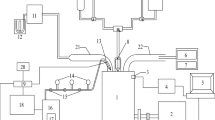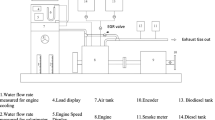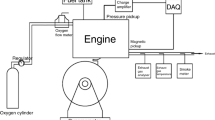Abstract
The present study investigates the effect of blending oxygenate namely diethylene glycol dimethyl ether (diglyme) with minor vegetable oil namely rubber seed oil (RSO), babassu oil (BSO), and their blends in various proportions (R75B25, R50B50, and R25B75) on NOx-smoke trade-off and other engine characteristics. The tests were conducted on a commercial twin cylinder compression–ignition (CI) engine commonly used in tractors. The potential of the blends with diglyme is assessed based on performance, emission, and combustion characteristics of the engine at different load conditions. The tests were conducted at a constant speed of 1500 rpm maintaining the original injection timing and pressure. Compared to diesel, RSO, and BSO, and their blends exhibited inferior combustion due to poor physical properties like high viscosity and density. This resulted in a lower brake thermal efficiency with increase in HC, CO, and smoke emissions compared to diesel at all the load conditions. The augmented effect is observed with increase in BSO proportion for the blends and neat BSO. The poor combustion of minor vegetable oil and its blends lead to lower NOx emission as a result of lower in-cylinder temperature. To improve the performance and NOx-smoke trade-off, diglyme (DGM) was added with all the test fuels with the optimum share of 20% (by volume). Addition of DGM, increased brake thermal efficiency by 2–7% for all the test fuels due to improved combustion as a result of additional fuel bound oxygen in DGM and improved fuel blend properties. DGM addition reduced smoke, HC, and CO emission drastically with a slight increase in NOx emission compared to minor vegetable oil blends. The study shows that addition of DGM showed a promising note in NOx-smoke trade-off without affecting the other engine parameters.









Similar content being viewed by others
References
Agarwal AK, Gupta JG, Dhar A (2017) Potential and challenges for large-scale application of biodiesel in automotive sector. Prog Energy Combust Sci 61:113–149
Atabani AE, Silitonga AS, Ong HC, Mahlia TMI, Masjuki HH, Badruddin IA, Fayaz H (2013) Non-edible vegetable oils: a critical evaluation of oil extraction, fatty acid compositions, biodiesel production, characteristics, engine performance and emissions production. Renew Sust Energ Rev 18:211–245
Barrios CC, Martin C, Dominguez-Saez A, Alvarez P, Pujadas M, Casanova J (2014) Effects of the addition of oxygenated fuels as additives on combustion characteristics and particle number and size distribution emissions of a TDI diesel engine. Fuel 132:93–100
Benajes J, Pastor JV, García A, Monsalve-Serrano J (2015) The potential of RCCI concept to meet EURO VI NOx limitation and ultra-low soot emissions in a heavy-duty engine over the whole engine map. Fuel 159:952–961
Bertoli C, Del Giacomo N, Beatrice C (1998) Evaluation of combustion behavior and pollutants emission of advanced fuel formulations by single cylinder engine experiments (no. 982492). SAE technical paper
Bhovi M, Banapurmath NR, Khandal SV, Yaliwal VS (2017) Effect of hydrogen and hydrogen enriched compressed natural gas induction on the performance of rubber seed oil methy ester fuelled common rail direct injection (CRDi) dual fuel engines. European Journal of Sustainable Development Research 1(2):07
Chen CY, Lee WJ, Wang LC, Chang YC, Yang HH, Young LH, Lu JH, Tsai YI, Cheng MT, Mwangi JK (2017) Impact of high soot-loaded and regenerated diesel particulate filters on the emissions of persistent organic pollutants from a diesel engine fueled with waste cooking oil-based biodiesel. Appl Energy 191:35–43
Corcione FE, Merola SS, Vaglieco BM, Formisano G (2001) In-cylinder optical analysis of CRDI diesel engine combustion (No. 2001-24-0027). SAE Technical Paper
de LT Oliveira G, McKay B, Plank C (2017) How biofuel policies backfire: misguided goals, inefficient mechanisms, and political-ecological blind spots. Energy Policy 108:765–775
Demirbas A (2009) Biofuels securing the planet’s future energy needs. Energy Convers Manag 50(9):2239–2249
Di Y, Cheung CS, Huang Z (2010) Experimental investigation of particulate emissions from a diesel engine fueled with ultralow-sulfur diesel fuel blended with diglyme. Atmos Environ 44(1):55–63
Geo VE, Nagarajan G, Nagalingam B (2008) A comparative combustion analysis of rubber seed oil and its methyl ester in a DI diesel engine (No. 2008-01-1386). SAE Technical Paper
Geo VE, Nagarajan G, Kamalakannan J, Nagalingam B (2009) Experimental investigations to study the characteristics of rubber-seed-oil-fueled diesel engine supplemented with diethyl ether. Energy Fuel 23(1):533–538
Geo VE, Sonthalia A, Nagarajan G, Nagalingam B (2017) Studies on performance, combustion and emission of a single cylinder diesel engine fuelled with rubber seed oil and its biodiesel along with ethanol as injected fuel. Fuel 209:733–741
Gill SS, Tsolakis A, Herreros JM, York APE (2012) Diesel emissions improvements through the use of biodiesel or oxygenated blending components. Fuel 95:578–586
Guan B, Zhan R, Lin H, Huang Z (2014) Review of state of the art technologies of selective catalytic reduction of NOx from diesel engine exhaust. Appl Therm Eng 66(1–2):395–414
Joshi G, Pandey JK, Rana S, Rawat DS (2017) Challenges and opportunities for the application of biofuel. Renew Sust Energ Rev 79:850–866
Kasiraman G, Geo VE, Nagalingam B (2016) Assessment of cashew nut shell oil as an alternate fuel for CI (compression ignition) engines. Energy 101:402–410
Kumar BR, Saravanan S, Rana D, Nagendran A (2016) Use of some advanced biofuels for overcoming smoke/NOx trade-off in a light-duty DI diesel engine. Renew Energy 96:687–699
Miyamoto N, Ogawa H, Nurun NM, Obata K, Arima T (1998) Smokeless, low NOx, high thermal efficiency, and low noise diesel combustion with oxygenated agents as main fuel (No. 980506). SAE technical paper
Nabi MN, Hustad JE (2012) Influence of oxygenates on fine particle and regulated emissions from a diesel engine. Fuel 93:181–188
Oliveira LE, Giordani DS, Paiva EM, De Castro HF, Da Silva MLCP (2013) Kinetic and thermodynamic parameters of volatilization of biodiesel from babassu, palm oil and mineral diesel by thermogravimetric analysis (TG). J Therm Anal Calorim 111(1):155–160
Pinzi S, Rounce P, Herreros JM, Tsolakis A, Dorado MP (2013) The effect of biodiesel fatty acid composition on combustion and diesel engine exhaust emissions. Fuel 104:170–182
Puzun A, Wanchen S, Guoliang L, Manzhi T, Chunjie L, Shibao C (2011) Characteristics of particle size distributions about emissions in a common-rail diesel engine with biodiesel blends. Procedia Environ Sci 11:1371–1378
Ramadhas AS, Jayaraj S, Muraleedharan C (2005) Biodiesel production from high FFA rubber seed oil. Fuel 84(4):335–340
Ramos MJ, Fernandez CM, Casas A, Rodriguez L, Perez A (2009) Influence of fatty acid composition of raw materials on biodiesel properties. Bioresour Technol 100:261–268
Ren Y, Huang Z, Miao H, Jiang D, Zeng K, Liu B, Wang X (2007) Effect of the addition of diglyme in diesel fuel on combustion and emissions in a compression− ignition engine. Energy Fuel 21(5):2573–2583
Ren Y, Huang Z, Miao H, Di Y, Jiang D, Zeng K, Liu B, Wang X (2008) Combustion and emissions of a DI diesel engine fuelled with diesel-oxygenate blends. Fuel 87(12):2691–2697
Sajjadi B, Raman AAA, Arandiyan H (2016) A comprehensive review on properties of edible and non-edible vegetable oil-based biodiesel: composition, specifications and prediction models. Renew Sust Energ Rev 63:62–92
Song H, Quinton KS, Peng Z, Zhao H, Ladommatos N (2016) Effects of oxygen content of fuels on combustion and emissions of diesel engines. Energies 9(1):28
Srihari S, Thirumalini S (2017) Investigation on reduction of emission in PCCI-DI engine with biofuel blends. Renew Energy 114:1232–1237
Subramanian T, Varuvel EG, Martin LJ, Beddhannan N (2017) Effect of lower and higher alcohol fuel synergies in biofuel blends and exhaust treatment system on emissions from CI engine. Environ Sci Pollut Res 24(32):25103–25113
Subramanian T, Varuvel EG, Ganapathy S, Vedharaj S, Vallinayagam R (2018) Role of fuel additives on reduction of NO X emission from a diesel engine powered by camphor oil biofuel. Environ Sci Pollut Res, 1–10
Tamanouchi M, Akimoto T, Aihara S, Morihisa H (1999) Effects of DGM and oxidation catalyst on diesel exhaust emissions (No. 1999-01-1137). SAE Technical Paper
Thiyagarajan S, Geo VE, Leenus JM, Nagalingam B (2017a) Experimental investigation to reduce CO2 emission in a single cylinder CI engine using low carbon fuel blend with Karanja oil methyl ester and amine injection in the exhaust manifold. Int J Global Warm 13(3–4):278–295
Thiyagarajan S, Geo VE, Martin LJ, Nagalingam B (2017b) Selective non-catalytic reduction (SNCR) of CO2 and NO emissions from a single-cylinder CI engine using chemical absorbents. Emission Control Science and Technology 3(3):233–242
Varuvel EG, Subramanian T, Khatri P (2017) Effect of diglyme addition on performance and emission characteristics of hybrid minor vegetable oil blends (rubber seed and babassu oil) in a tractor engine–an experimental study. Biofuels, 1–9
Vedharaj S, Vallinayagam R, Yang WM, Saravanan CG, Lee PS (2015) Optimization of combustion bowl geometry for the operation of kapok biodiesel–diesel blends in a stationary diesel engine. Fuel 139:561–567
Walsh MP (1999) Assessing transportation-related air pollution in major cities. J Urban Technol 6(1):1–24
Zheng M, Han X, Asad U, Wang J (2015) Investigation of butanol-fuelled HCCI combustion on a high efficiency diesel engine. Energy Convers Manag 98:215–224
Author information
Authors and Affiliations
Corresponding author
Additional information
Responsible editor: Philippe Garrigues
Rights and permissions
About this article
Cite this article
Varuvel, E.G., Sonthalia, A., Subramanian, T. et al. NOx-smoke trade-off characteristics of minor vegetable oil blends synergy with oxygenate in a commercial CI engine. Environ Sci Pollut Res 25, 35715–35724 (2018). https://doi.org/10.1007/s11356-018-3484-y
Received:
Accepted:
Published:
Issue Date:
DOI: https://doi.org/10.1007/s11356-018-3484-y




